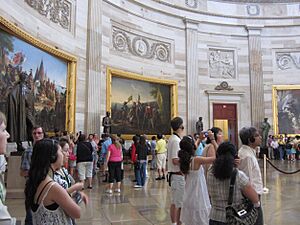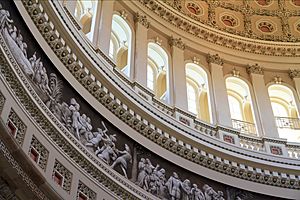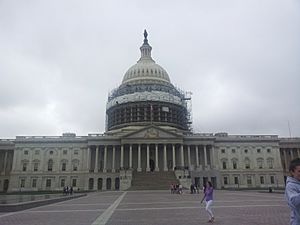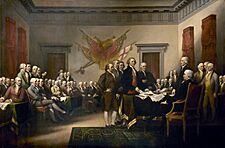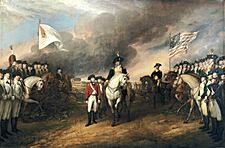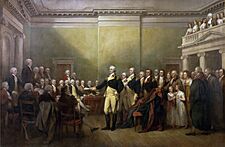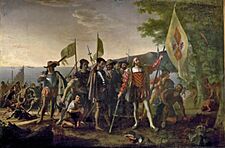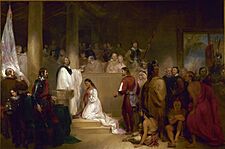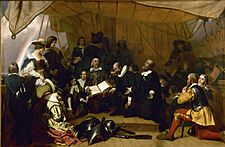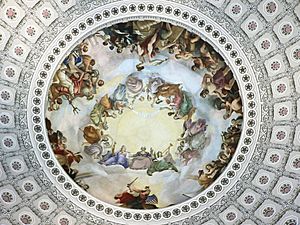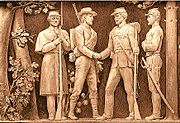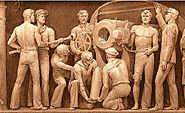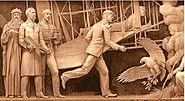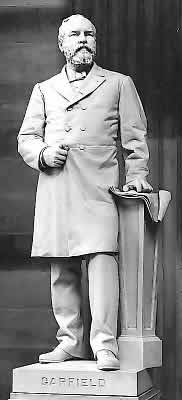United States Capitol rotunda facts for kids
The United States Capitol building has a big, round room called the Rotunda right under its famous dome. It was built between 1818 and 1824 and is often called the "heart" of the Capitol building because it's so important and central.
The Rotunda connects to hallways that lead to the House of Representatives (where laws are made) and the Senate chambers. Nearby, you'll find the National Statuary Hall, which used to be the House chamber, and the Old Senate Chamber, which was once used by the Senate and later by the Supreme Court.
This impressive room is 96 feet (29 m) wide and rises 180 feet 3 inches (54.94 m) to the top of the dome's canopy. Thousands of people visit it every day. It's like a national art gallery, filled with historical paintings and sculptures. Important events, like honoring famous people who have passed away, also happen here.
Contents
Building the Rotunda
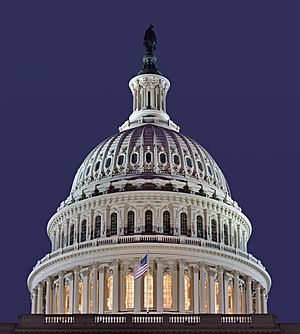
The idea for a central rotunda came from Dr. William Thornton, who won the competition to design the Capitol in 1793. However, building it took a long time because of money problems, interruptions, and even an attack on Washington by the British during the War of 1812.
Work on the Rotunda finally began in 1818. It was finished in 1824 by Architect of the Capitol Charles Bulfinch. The design was inspired by the neoclassical style, similar to the ancient Pantheon in Rome.
The Rotunda's sandstone walls are 48 feet (15 m) tall. Everything above that, including the Capitol dome, was designed later in 1854 by Thomas U. Walter. He was the fourth Architect of the Capitol. Work on the dome started in 1856. In 1859, Walter redesigned the Rotunda to have an inner and outer dome, with a special canopy hanging between them.
In 1862, Walter asked the painter Constantino Brumidi to create a large painting for the dome's canopy. This painting, called The Apotheosis of Washington, is 65 feet (20 m) wide. The dome was made from fireproof cast iron and was completed in 1866, even though the American Civil War was happening. During the war, the Rotunda was even used as a military hospital for Union soldiers.
The Crypt Below
Below the Rotunda is a space called the crypt. Originally, the ceiling of the crypt was open to the Rotunda above. You can still see holes in the stone floor that show where this opening was. Underneath the crypt floor, there's a tomb that was meant for George Washington. However, after discussions with his family and the state of Virginia, he was never buried there.
Rotunda Renovation
In 2013, a four-year project began to fix and preserve the Capitol Dome and Rotunda. This project involved removing old lead paint, repairing the ironwork, repainting the inside of the dome, and installing new lights. The dome and Rotunda hadn't been fully fixed up since 1960 and were showing signs of rust. There was even a risk that parts of the decorative ironwork could fall. Safety nets were put up to protect visitors while the work was being done.
Historical Paintings
The Rotunda has eight large historical paintings displayed in special spaces called niches. All of them are oil-on-canvas and measure 12 by 18 feet (3.7 by 5.5 metres).
Four of these paintings show scenes from the American Revolution. They were painted by John Trumbull, who was hired by Congress in 1817. These paintings are:
- Declaration of Independence
- Surrender of General Burgoyne
- Surrender of Lord Cornwallis
- General George Washington Resigning His Commission
These four were put up between 1819 and 1824. Between 1840 and 1855, four more paintings were added. These show the exploration and early settlement of America and were painted by different artists:
- Landing of Columbus by John Vanderlyn
- Discovery of the Mississippi by William Henry Powell
- Baptism of Pocahontas by John Gadsby Chapman
- Embarkation of the Pilgrims by Robert Walter Weir
| Painting | Artist | What it Shows |
|---|---|---|
| John Trumbull | John Adams, Thomas Jefferson, and others from the Committee of Five present the Declaration of Independence to John Hancock and the Second Continental Congress in 1776. | |
| John Trumbull | British soldiers led by General John Burgoyne surrender after the American victory at the Battle of Saratoga in 1777. | |
| John Trumbull | American and French forces led by George Washington accept the surrender of British troops after the Battle of Yorktown in 1781. | |
| John Trumbull | George Washington tells Congress he is stepping down as commander-in-chief of the Continental Army in 1783. | |
| John Vanderlyn | Christopher Columbus arrives in the Americas, claiming the land for Spain in 1492. | |
| William Henry Powell | Spanish explorer Hernando de Soto and his troops encounter Native Americans, with a monk setting up a cross. | |
| John Gadsby Chapman | Pocahontas is baptized (given the name "Rebecca") before her marriage to John Rolfe in Jamestown. | |
| Robert Walter Weir | The Pilgrims pray on the ship Speedwell as they leave Delfshaven in 1620, heading for America. |
The Apotheosis of Washington
The Apotheosis of Washington is a huge painting on the ceiling of the dome, painted by Constantino Brumidi. You can see it by looking up through the opening in the dome. It shows George Washington looking like a god in the heavens. This painting is 180 feet (55 m) above the floor and covers a large area of 4,664 square feet (433.3 m2).
The Frieze of American History
The Frieze of American History is a painting that looks like carved stone, but it's actually a special type of painting called a trompe-l'œil fresco. It shows 19 scenes from American history and wraps around the Rotunda just below the windows.
Brumidi started painting the frieze in 1878. He painted seven and a half scenes before he fell from the scaffolding and sadly died a few months later in 1880. After his death, Filippo Costaggini finished the remaining scenes based on Brumidi's sketches. He completed his work in 1889, but there was a 31-foot (9 m) gap left because of a mistake in Brumidi's original plan. In 1951, Allyn Cox finished the last part of the frieze.
The scenes in the frieze show important moments in American history. Here are some of them:
| Scene | Artist | What it Shows |
|---|---|---|
| ''''' | Constantino Brumidi | A symbolic scene of America, with a figure representing the country surrounded by other figures like a Native American maiden and a personification of History. |
| Constantino Brumidi | Christopher Columbus arriving in the Americas, greeted by Native Americans. | |
| Constantino Brumidi | Spanish conqueror Hernán Cortés meeting Moctezuma II in an Aztec temple. | |
| Constantino Brumidi | Spanish conqueror Francisco Pizarro exploring the jungle in search of gold in Peru. | |
| Constantino Brumidi | The burial of Spanish explorer Hernando de Soto in the Mississippi River. | |
| Constantino Brumidi | Pocahontas saving Captain John Smith from danger. | |
| Constantino Brumidi | The Pilgrims giving thanks to God after arriving on the Mayflower. | |
| Constantino Brumidi Completed by Filippo Costaggini |
William Penn meeting with Lenape Native Americans under an elm tree. | |
| Designed by Constantino Brumidi Completed by Filippo Costaggini |
Settlers in New England building with lumber. | |
| Designed by Constantino Brumidi Completed by Filippo Costaggini |
James Oglethorpe meeting with Muskogee leaders in Savannah, Georgia. | |
| Designed by Constantino Brumidi Completed by Filippo Costaggini |
The "shot heard 'round the world" at the Battle of Lexington, starting the American Revolutionary War. | |
| Designed by Constantino Brumidi Completed by Filippo Costaggini |
John Adams, Thomas Jefferson, and Benjamin Franklin reading the Declaration of Independence to colonists. | |
| Designed by Constantino Brumidi Completed by Filippo Costaggini |
George Washington receiving the surrender from British troops after the Battle of Yorktown. | |
| Designed by Constantino Brumidi Completed by Filippo Costaggini |
The death of Shawnee chief Tecumseh during the War of 1812. | |
| Designed by Constantino Brumidi Completed by Filippo Costaggini |
U.S. Army troops entering Mexico City after the Mexican–American War. | |
| Designed by Constantino Brumidi Completed by Filippo Costaggini |
Prospectors searching for gold during the California Gold Rush. | |
| Allyn Cox | A Confederate and a Union soldier shaking hands, symbolizing the end of the American Civil War. | |
| Allyn Cox | United States Navy sailors in a gun crew during a naval battle in the Spanish–American War. | |
| Allyn Cox | The Wright brothers' first flight at Kitty Hawk in 1903. |
Statues in the Rotunda
The Rotunda is home to many important statues. Seven of them are from the National Statuary Hall Collection and represent presidents:
- George Washington from Virginia
- Andrew Jackson from Tennessee
- James Garfield from Ohio
- Dwight D. Eisenhower from Kansas
- Ronald Reagan from California
- Gerald Ford from Michigan
- Harry S. Truman from Missouri
These statues of presidents will stay in the Rotunda unless Congress decides otherwise.
George Washington Statue
A bronze statue of George Washington is very important in the Rotunda. It's a copy of a famous marble statue made by French sculptor Jean-Antoine Houdon in 1790. The original is in the Virginia State Capitol.
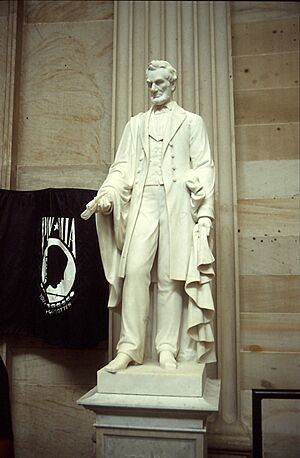
James Garfield Statue
James Garfield was a U.S. president who was born in a log cabin. The sculptor Charles Niehaus was chosen to create a monument to President Garfield after he was assassinated, because both Niehaus and Garfield were from Ohio.
Bust of Martin Luther King, Jr.
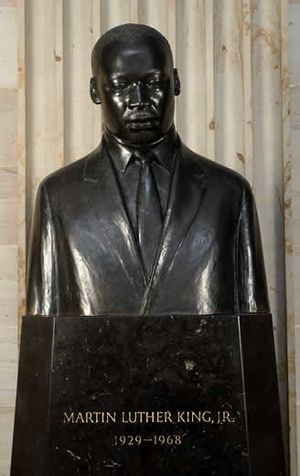
There is a bust (a sculpture of the head and shoulders) of Martin Luther King, Jr. in the Rotunda. It is 36 inches (91 cm) high and sits on a tall black marble base. Congress decided to hold a national competition to choose the artist for this important artwork.
The bust was made by John Woodrow Wilson and was revealed in the Rotunda on January 16, 1986. This date was the fifty-seventh anniversary of King's birth. His wife, children, and sister were there for the ceremony.
Women's Suffrage Monument
This large sculpture is officially called the Portrait Monument to Lucretia Mott, Elizabeth Cady Stanton, and Susan B. Anthony. These three women were pioneers in the women's suffrage movement, which worked to give women the right to vote. Their efforts, along with others like Alice Paul, led to the 19th Amendment in 1920, which finally gave women the right to vote.
The sculpture was made by Adelaide Johnson from a huge block of marble in Italy. It shows detailed busts of the three women. The top part of the sculpture is left rough, which some people say represents the ongoing work for women's rights. The monument was given to the Capitol by the National Woman's Party and was unveiled in the Rotunda on February 15, 1921.
-
l. to r.: Elizabeth Cady Stanton, Lucretia Mott, Susan B. Anthony
After it was first shown, the statue was moved to the Capitol Crypt for 75 years. In 1997, it was moved back to its current place in the Rotunda.
Other Statues and Art
Besides these, there are other artworks in the Rotunda. Near the south entrance, there's a bronze statue of Thomas Jefferson holding the Declaration of Independence. This statue was given by a private donor, Uriah P. Levy, making it unique.
At the west entrance, you'll find marble statues of General Ulysses S. Grant and President Abraham Lincoln. The Lincoln statue was created by Vinnie Ream. The Grant statue was a gift from the Grand Army of the Republic.
Lying in State and Honor
The Capitol Rotunda is a special place where important people are honored after they pass away. This ceremony is called "lying in state" or "lying in honor."
The main difference is who is being honored.
- Lying in state is for government officials or military officers. A guard of honor from the United States Armed Forces watches over their casket. Many presidents, like Abraham Lincoln and John F. Kennedy, have lain in state here.
- Lying in honor is for private citizens who have done great things for the country. The United States Capitol Police serve as the guard of honor. For example, Rosa Parks, a civil rights hero, lay in honor in the Rotunda.
Many notable people have been honored in the Rotunda, including presidents, military leaders, and civil rights activists, showing their importance to the nation.
See also
 In Spanish: Rotonda del Capitolio para niños
In Spanish: Rotonda del Capitolio para niños



